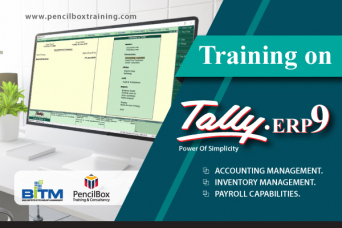- +8809612342486
- [email protected]

Tally.ERP 9 provides you with exceptional capabilities that will simplify the way you manage all critical aspects of your business, including accounting, sales and purchase, inventory,payroll & more.
Course Outline:
Chapter 1: Fundamentals of Accounting
1.1 Introduction
1.2 Accounting Terms
1.3 Accounting Assumptions, Concepts and Principles
1.3.1 Assumptions
1.3.2 Concepts
1.3.3 Principles
1.4 Double Entry System of Accounting
1.5 Types of Accounts
1.6 Golden Rules of Accounting
1.7 Source Documents for Accounting
Key Takeaways
Practice Exercises
Chapter 2: Maintaining Chart of Accounts in Tally.ERP 9
2.1 Introduction
2.1.1 Getting Started with Tally.ERP 9
2.1.2 Mouse and Keyboard Conventions
2.2 Company Creation
2.2.1 Shut a Company
2.2.2 Select a Company
2.2.3 Alter a Company
2.3 Company Features and Configurations
2.3.1 Company Features: F11
2.3.2 Configuration: F12
2.3 Chart of Accounts
2.4.1 Ledger
2.4.2 Group
2.5 Ledger Creation
2.5.1 Single Ledger Creation
2.5.2 Multi Ledger Creation
2.5.3 Altering and Display of Ledgers
2.5.3.1 Ledger Alteration
2.5.3.2 Single Ledger Display
2.5.3.3 Multi Ledger Display
2.5.4 Deleting Ledgers
2.6 Group Creation
2.6.1 Single Group Creation
2.6.2 Multiple Group Creation
2.6.3 Altering and Display of Groups
2.6.3.1 Group Alteration
2.6.3.2 Single Group Display
2.6.3.3 Multi Group Display
2.6.4 Deleting Groups
Key Takeaways
Shortcut Keys
Practice Exercises
Chapter 3: Fundamentals of Inventory Management
3.1 Introduction
3.2 Inventory Management
3.3 Terms Used in Inventory Management
3.4 Inventory Valuation
3.4.1 Different Types of Inventory Valuation
3.5 Inventory Management in Tally.ERP 9
Conclusion
Practice Exercise
Chapter 4: Stock Keeping Units
4.1 Introduction
4.2 Inventory Masters in Tally ERP 9
4.3 Creating Inventory Masters
4.3.1 Creation of Stock Group
4.3.2 Creation of Unit of Measure
4.3.3 Creation of Stock Item
4.3.4 Creation of Godown
4.3.5 Defining of Stock Opening Balance in Tally ERP 9
Key Takeaways
Shortcut Keys
Practice Exercises
Chapter 5: Recording Day to Day Transactions
5.1 Introduction
5.2 Business Transactions
5.2.1 Source Document or Voucher
5.2.2 Recording Transactions in Tally.ERP 9
5.3 Accounting Vouchers
5.3.1 Receipt Voucher
5.3.2 Contra Voucher
5.3.3 Payment Voucher
5.3.4 Purchase Voucher
5.3.5 Sales Voucher
5.3.6 Debit Note Voucher
5.3.7 Credit Note Voucher
5.3.8 Journal Voucher
5.4 Creation of New Voucher Type
5.5 Automation of Invoices (Voucher Classes)
5.6 Non-Accounting Vouchers
5.6.1 Memorandum Voucher
5.6.2 Optional Vouchers
5.6.3 Reversing Journal
5.7 Recording Provisional Entries
5.8 Recording Inventory Vouchers
5.8.1 Receipt Note Voucher
5.8.2 Delivery Note Voucher
5.8.3 Rejection In Voucher
5.8.4 Rejection Out Voucher
5.8.5 Stock Journal Voucher
5.8.6 Physical Verification of Stocks
Conclusion
Key Takeaways
Shortcut Keys
Practise Exercises
Chapter 6: Accounts Receivable and Payable Management
6.1 Introduction
6.2 Accounts Payable and Receivable
6.3 Maintaining Bill-wise Details
6.4 Activation of Maintaining Bill-wise Details Feature
6.5 New Reference
6.6 Against Reference
6.7 Advance Reference
6.8 On Account
6.9 Credit Limit
6.9.1 Activate Credit Limit
6.9.2 Setting Credit Limits
6.9.3 Exceeding Credit Limits
6.9.4 Exception to Credit Limits
6.10 Payment Performance of Debtors
6.11 Changing the Financial Year in Tally.ERP 9
Conclusion
Key Takeaways
Shortcut Keys
Practice Exercises
Chapter 7: Banking
7.1 Introduction
7.2 Banking Payments
7.3 Setting up Banking Features
7.4 Cheque Management
7.4.1 Cheque Printing
7.4.1.1 Single Cheque Printing
7.4.1.2 Multi Cheque Printing
7.4.2 Cheque Register
7.4.2.1 Cancelled Cheque
7.4.2.2 Blank Cheque
7.5 Bank Reconciliation
7.5.1 Manual Bank Reconciliation
7.5.2 Auto Bank Reconciliation
7.6 Deposit Slip
7.6.1 Cash Deposit Slip
7.6.2 Cheque Deposit Slip
7.7 Payment Advice
7.8 Managing of Post-dated Cheques
7.9 Notional Bank
7.10 Post-dated Report
Conclusion
Key Takeaways
Shortcut Keys
Practice Exercises
Chapter 8: Allocation and Tracking of Expenses and Incomes
8.1 Introduction
8.2 Cost Centre and Cost Categories
8.2.1 Activation of Cost Category and Cost Centre
8.2.2 Allocation of Expenses and Incomes using Cost Centre
8.2.3 Allocation of Expenses and Incomes using Cost Centre with Cost category
8.2.3.1 Allocation of expenses to multiple cost centres and cost categories
8.3 Automation of Cost Centre and Cost Categories while recording transactions
8.3.1 Cost Centre Classes
8.4 Cost Centre Reports
8.4.1 Category Summary
8.4.2 Cost Centre Break-up
8.4.3 Ledger Break-up
8.4.4 Group Break-up
Conclusion
Key Takeaways
Shortcut Keys
Practice Exercises
Chapter 9: MIS Reports
9.1 Introduction
9.2 Advantages of Management Information Systems
9.3 Types of MIS Reports in Tally.ERP 9
9.4 MIS Reports in Tally. ERP 9
9.4.1 Trial Balance
9.4.2 Balance Sheet
9.4.3 Profit and Loss Account
9.4.4 Cash Flow Statement
9.4.5 Funds Flow Statement
9.4.6 Ratio Analysis
9.4.7 Books and Accounting Reports
9.4.7.1 Day Book
9.4.7.2 Receipts and Payments
9.4.7.3 Purchase Register
9.4.7.4 Sales Register
9.4.7.5 Bills Receivable and Bills Payable
9.4.8 Inventory Reports
9.4.8.1 Stock Summary
9.4.8.2 Stock Transfer
9.4.8.3 Movement Analysis
9.4.8.4 Ageing Analysis
Key Takeaways
Shortcut Keys
Practise Exercises
| Training | Training on Tally.ERP9 | 15 Hrs |